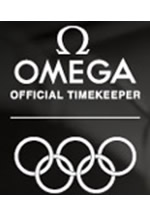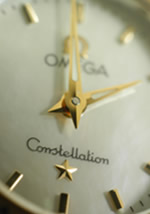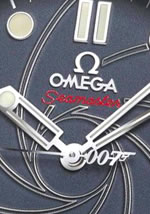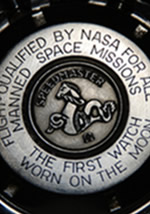 Omega is the last letter of the Greek alphabet and it represents perfection and success in the attainment of a task. The Omega story began in 1848 at La Chaux-de-Fonds, Switzerland, when its founder Louis Brandt at the age of 23 opened a comptoir d'établissage, a sub-contracting sales office for watch manufacture.. In 1880, due to the greater supply of manpower, communications and energy, Louis-Paul and Cesar Brandt moved into a small factory in the city of Bienne /Biel. With the introduction of their first series-produced calibers, Labrador and Gurzelen, in 1895 the watches achieved a precision of within 30 seconds a day.
Omega is the last letter of the Greek alphabet and it represents perfection and success in the attainment of a task. The Omega story began in 1848 at La Chaux-de-Fonds, Switzerland, when its founder Louis Brandt at the age of 23 opened a comptoir d'établissage, a sub-contracting sales office for watch manufacture.. In 1880, due to the greater supply of manpower, communications and energy, Louis-Paul and Cesar Brandt moved into a small factory in the city of Bienne /Biel. With the introduction of their first series-produced calibers, Labrador and Gurzelen, in 1895 the watches achieved a precision of within 30 seconds a day. Four years later, Louis Brandt & Fils became the largest producers of watches in Switzerland, with a production rate of 240,000 watches produced annually and employing 800 people. But this fact did not stop the exclusivity of the watches they produced: a clear example is the minute-repeating wristwatch, developed in 1892 in partnership with Audemars Piguet, and probably the first wristwatch of its kind. The famous Omega caliber became a brilliant market performer when it went into production in 1894. Its major points for salability were in its easily interchangeable parts, and its simplicity of construction. The company's banker, Henri Rieckel, suggested the name "Omega" for the new watch. The overwhelming success of the "Omega" name led to it being adopted as the sole name for all the watches of the company from 1903.
Both Brandt brothers died in 1903, placing the fate of the company in the control of four people, the oldest of which, Paul-Emile Brandt, was only 23 years of age.
Omega made its debut in sports during the international ballooning for the Gordon Bennet cup contest timing several events. The British Royal Flying Corps decided to choose Omega watches in 1917 as their official timekeepers for its combat units, as did the American army in 1918. Omega was the first company to be entrusted with the official timekeeping of all disciplines at the Los Angeles Games in 1932. From sports to scientific scuba-diving, the Omega Seamaster line was created.
One of Omega's most noteworthy achievement was the world record of accuracy granted by the English observatory of Kew-Teddington in 1936.
In 1952, Omega was also awarded the Olympic Cross of Merit for "exceptional services to the world of sport".
The Omega Speedmaster was created in 1957. After rigorous evaluation and testing, NASA decided to use the "Omega Speedmaster Professional Chronograph wristwatch in 1965 as its official timekeeper. In 1967, the one millionth chronometer was certified.
On 21st July 1969, astronaut Neil Armstrong became the first man to step on the moon. As he made the famous steps quoting "one small step for man, one giant leap for mankind", h e was wearing his Omega Speedmaster Professional chronograph. With this unique accomplishment came a unique nickname: the Moon Watch.
e was wearing his Omega Speedmaster Professional chronograph. With this unique accomplishment came a unique nickname: the Moon Watch.
In April 1970 the Omega Speedmaster rescued the Apollo XIII mission from a potential disaster, earning Omega the "Snoopy Award", the highest distinction granted by NASA.
The Russian Space Agency also chose the Omega Speedmaster chronographs to accompany their astronauts.
In 1974 Omega produces Marine Chronometer 2400 which is the most accurate and the most technologically advanced wristwatch in the world. This legendary "Omega Megaquartz" marine-chronometer had a daily timing variation of just two thousands of a second, in a trial lasting for 63 days.
In its search of elegance, Omega has relied on the most prestigious jeweler designers and created real masterpieces of the highest refinement. As a result, in 1985, Omega received the Triomphe de l'excellence européenne prize for the quality and originality of its models.
On the 18th of May 1983, Omega received its 100,000th official rating certificate for quartz chronometers. A museum for the company was opened on 16th December 1983. In 1995, presentations were made of the first automatic wristwatch with a centrally mounted tourbillion. In 1999 Omega made history by introducing the first mass-produced watch incorporating the revolutionary "co-axial escapement"- invented by English watchmaker George Daniels. Considered by many to be one of the most significant horological advancements since the invention of the lever escapement, the co-axial escapement functions with virtually no lubrication thereby eliminating one of the shortcomings of the traditional lever escapement. This improvement has extended service intervals to around 10 years.





No comments:
Post a Comment